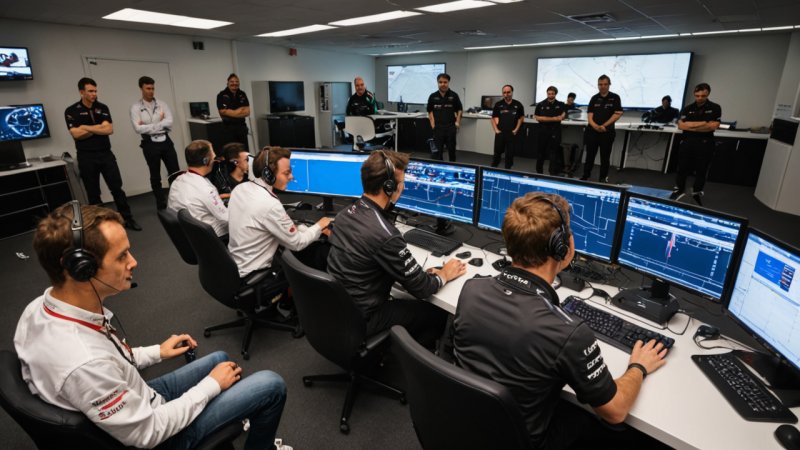The world of motorsports is evolving rapidly, with data analytics emerging as a pivotal tool for teams and drivers aiming to gain a competitive advantage. By leveraging cutting-edge technology and sophisticated analytical methods, racing professionals can uncover insights that enhance performance, inform strategic decisions, and ultimately lead to victory on the track. This article delves into the various dimensions of data analytics in racing, exploring its significance, applications, and the future of this transformative approach.
Understanding Data Analytics in Racing
Data analytics refers to the systematic computational analysis of data sets to uncover patterns, correlations, and insights. In the context of racing, this involves collecting vast amounts of data from various sources, including vehicle telemetry, track conditions, and driver performance metrics. The goal is to transform this data into actionable insights that can optimize racing strategies and improve overall performance.
The Importance of Data Analytics in Motorsports
In motorsports, where milliseconds can determine the difference between victory and defeat, data analytics plays a critical role. Here are several reasons why it is crucial:
- Performance Optimization: By analyzing data from practice sessions and races, teams can identify areas for improvement in vehicle setup, driver technique, and tire management.
- Predictive Analysis: Data analytics allows teams to make predictions about race outcomes based on historical performance, weather conditions, and track characteristics.
- Strategic Decision-Making: Teams can make informed decisions regarding pit stops, tire changes, and race strategies based on real-time data analysis.
- Injury Prevention: By analyzing driver fatigue and physical performance data, teams can implement strategies to reduce the risk of injuries.
Key Data Sources in Racing
To effectively utilize data analytics, racing teams must gather data from multiple sources. These sources include:
Telemetry Data
Telemetry systems collect real-time data from vehicles during practice and races. This data includes speed, acceleration, brake pressure, and steering inputs. By analyzing telemetry data, teams can gain insights into vehicle performance and driver behavior.
Weather Data
Weather conditions can significantly impact race outcomes. Teams utilize weather data to adjust their strategies, such as tire selection and pit stop timing. Advanced analytics can help predict weather changes and their potential effects on the race.
Driver Performance Metrics
Data on driver performance, including lap times, reaction times, and physical exertion levels, can help teams understand how to optimize a driver's performance. Wearable technology can provide real-time feedback on driver health and fatigue levels, enabling teams to make informed decisions during races.
Track Conditions
Track data, such as grip levels, surface temperature, and wear patterns, can inform teams about the optimal setup for their vehicles. By analyzing this data, teams can adjust their strategies to enhance performance based on current track conditions.
Applications of Data Analytics in Racing
Racing teams employ data analytics in various applications to enhance performance and strategic planning:
Vehicle Performance Analysis
Data analytics is used to assess vehicle performance, including handling, speed, and fuel efficiency. Teams can simulate different setups and configurations to identify the optimal balance between speed and handling.
Driver Training and Development
By analyzing driver performance data, teams can tailor training programs to address specific weaknesses. This personalized approach helps drivers improve their skills and performance in targeted areas.
Race Strategy Optimization
Data analytics enables teams to develop sophisticated race strategies based on predictive modeling. Analyzing historical race data helps teams identify successful strategies and adapt them to current conditions.
Fan Engagement and Experience
Data analytics is also employed to enhance fan engagement. By analyzing fan behavior and preferences, teams can create targeted marketing strategies, improve event experiences, and deepen fan loyalty.
Challenges in Implementing Data Analytics
Despite its benefits, implementing data analytics in racing comes with challenges:
Data Overload
With the vast amounts of data generated during races, teams may struggle to process and analyze all the information effectively. Prioritizing key metrics and focusing on actionable insights is essential.
Integration of Systems
Combining data from different sources and systems can be complex. Ensuring that all data is compatible and can be analyzed cohesively is vital to maximize insights.
Skill Gap
Not all teams have the expertise to analyze data effectively. Investing in training or hiring skilled analysts can be necessary to fully leverage data analytics.
Future Trends in Racing Data Analytics
As technology continues to evolve, the future of data analytics in racing looks promising:
Artificial Intelligence and Machine Learning
The integration of AI and machine learning into data analytics will enhance predictive modeling capabilities. These technologies can analyze complex data sets more efficiently and identify patterns that humans may overlook.
Enhanced Wearable Technology
Advancements in wearable technology will provide even more granular data on driver performance and health. This will allow teams to monitor driver fatigue and optimize their training regimens.
Real-Time Data Sharing
With advancements in communication technology, real-time data sharing between teams, drivers, and engineers during races will become more seamless. This will allow for quicker adjustments and strategy changes on the fly.
Conclusion
Data analytics has transformed the landscape of motorsports, providing teams and drivers with the insights needed to optimize performance and make strategic decisions. By harnessing the power of data from various sources, racing professionals can enhance their competitiveness while prioritizing safety and performance. As technology continues to advance, the potential for data analytics in racing will only grow, paving the way for new innovations and strategies that can redefine the sport.






